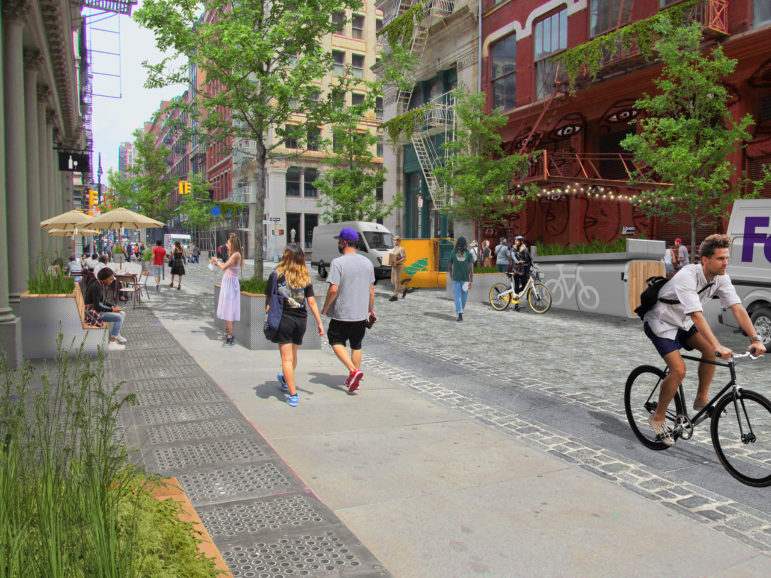‘SoHo is a picturesque, architectural gem of a place to live and work…But it is also an impossible mess of traffic, mini skyscrapers of garbage bags, and elbow wars of crowds in the street and on the sidewalk.’

Courtesy of the SoHo Broadway Initiative
A rendering of the SoHo Broadway Initiative Public Realm Plan.On a recent sunny Sunday morning in SoHo, my family and I prepped for an exciting moment—my daughter Sammy’s first bicycle ride. Sammy is 14 with a thick curtain of red hair and a smile that never seems to leave her face. She has Angelman’s Syndrome, a disorder causing developmental disabilities; hence her first bike ride so late in the game.
She helmeted up and took her seat on the bike, one that is built for extra safety for those with special needs. We made it two beautiful blocks on Grand Street when the reality of SoHo set in.
Crowds. Yelling. Honking. When we hit Broadway the bike lane was blocked by cars and pedestrians navigating the traffic. Sammy’s bike hit a curb and flew over. Sammy and I went down. And there was no extra room to really pick ourselves back up and start again—it was like trying to get out of a parade crowd, which, as a New Yorker, is the ultimate nightmare.
SoHo is a picturesque, architectural gem of a place to live—and work (my business, Sloomoo Institute, an interactive museum, is around the corner from my apartment). But it is also an impossible mess of traffic, mini skyscrapers of garbage bags, and elbow wars of crowds in the street and on the sidewalk.
My family has spent over two decades living in and enjoying the haven of shopping, restaurants, and culture in our neighborhood. It has all been replaced by a never-ending cacophony of honking cars, while navigating the pedestrian walking spaces has become akin to an Olympic sport.
As life has come back from the worst of the COVID-19 quarantine, pedestrian infrastructure seems to have disappeared beneath a sea of crowds and traffic. It has become difficult to even cross the street lately.
One solution has been shared by the SoHo Broadway Initiative in their recently released Public Realm Framework and Vision Plan, a fresh image of SoHo, where streets are reoriented for people and community, not cars. The pandemic has forced us all to seriously reconsider how public space is used—and, more importantly, whom public space is for.
We’ve all seen the tremendous success that other neighborhoods have had with creating pedestrian areas and removing traffic. A great example of this is Union Square, now a hub of greenmarket browsers, shoppers, and residents enjoying the public open space.
 CityViews are readers’ opinions, not those of City Limits. Add your voice today!
CityViews are readers’ opinions, not those of City Limits. Add your voice today!
The SoHo Broadway Initiative Public Realm Plan will, among other things, expand sidewalk width by at least 50 percent and divert car traffic away from the neighborhood, giving buses space to pick up and drop off travelers safely, and ensuring bikes can easily navigate these streets.
This will not only allow families to enjoy the area they love but also create a feeling of safety for those who truly need it in order to simply walk. It will boost foot traffic, which benefits the local economy, creating financial security for businesses and increasing overall livelihood in the area.
I’m not foremost interested in the SoHo Broadway Initiative’s plans out of commercial motivations, however. People—not businesses—will stand to benefit the most from these plans. By making all 27 intersections in the district ADA-accessible, essentially making them curbless and creating public seating areas throughout the neighborhood, we would have the ability to plant trees, increase greenery, and carve out room for people like my family, as well as the elderly who need a place to rest, parents with strollers, and those who simply wish to take in the neighborhood without battling noise and the feeling of pushy anxiety from crowding.
The plan is to make SoHo more welcoming and more human. These are not radical changes, but ones that will make a radical difference and improve the quality of life we have all come to value more since having to face the harsh realities of COVID.
Sara Schiller is co-founder of the Sloomoo Institute, an interactive museum centered on slime; co-founder of the Wooster Collective, a celebration of street art across the world; and a longtime resident of SoHo.









One thought on “Opinion: Redesigning SoHo’s Streets for People and Community”
A great example of this is Union Square, now a hub of greenmarket browsers, shoppers, and residents enjoying the public open space.